Introduced 1965 Top speed 912 km/h Length 51 m | Retired 5 May 2006 Wingspan 49 m Engine type Pratt & Whitney TF33-P-7 | |
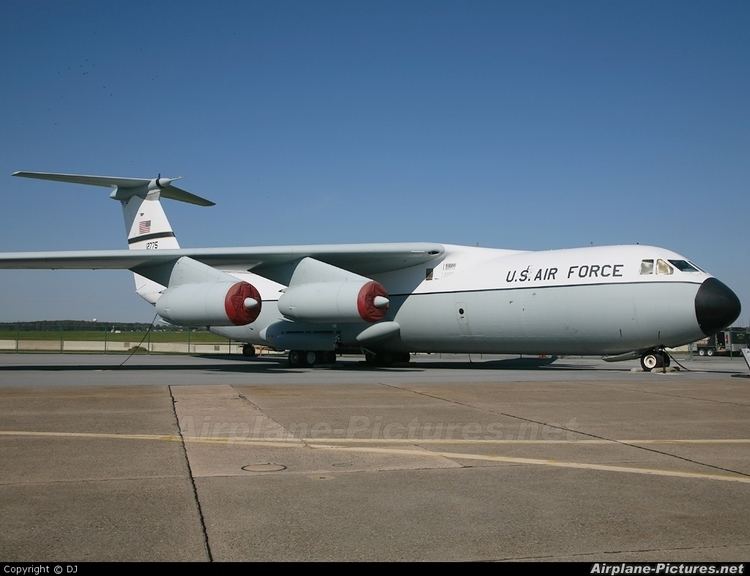 | ||
Lockheed c 141 starlifter
The Lockheed C-141 Starlifter was a military strategic airlifter in service with the Military Air Transport Service (MATS), its successor organization the Military Airlift Command (MAC), and finally the Air Mobility Command (AMC) of the United States Air Force (USAF). The aircraft also served with airlift and air mobility wings of the Air Force Reserve (AFRES), later renamed Air Force Reserve Command (AFRC), the Air National Guard (ANG) and, later, one air mobility wing of the Air Education and Training Command (AETC) dedicated to C-141, C-5, C-17 and KC-135 training.
Contents
- Lockheed c 141 starlifter
- Design and development
- Operational history
- C 141A
- C 141B
- SOLL II
- C 141C
- Operators
- Accidents
- Aircraft on display
- Specifications C 141B Starlifter
- References
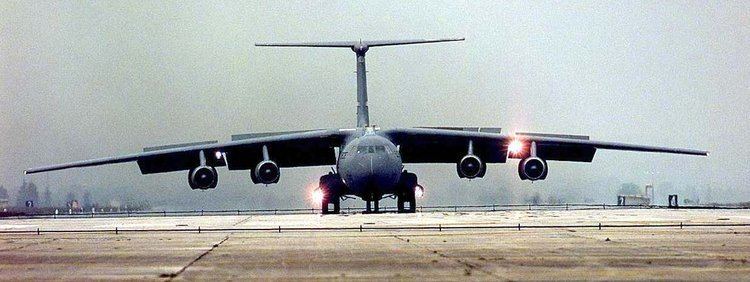
Introduced to replace slower propeller driven cargo planes such as the C-124 Globemaster II and C-133 Cargomaster, the C-141 was designed to requirements set in 1960 and first flew in 1963. Production deliveries of an eventual 285 planes began in 1965: 284 for the Air Force, and one for the National Aeronautics and Space Administration (NASA) for use as an airborne observatory. The aircraft remained in service for over 40 years until the USAF withdrew the last C-141s from service in 2006, after replacing the airlifter with the C-17 Globemaster III.
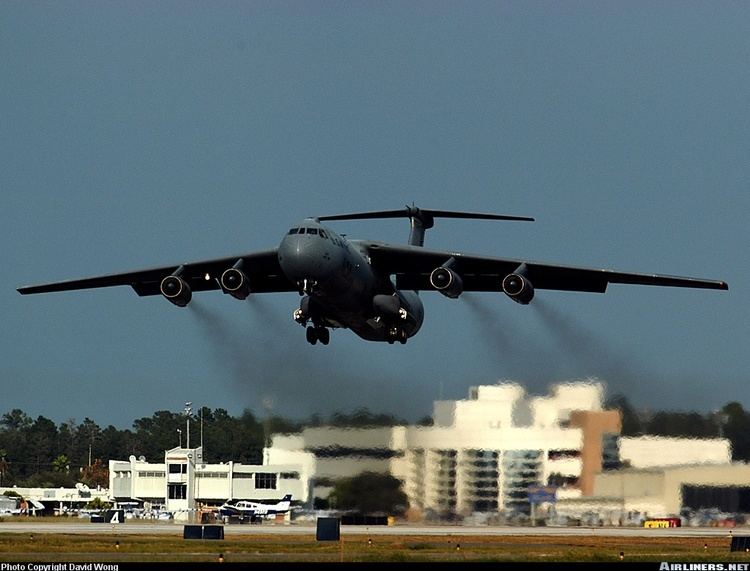
Design and development
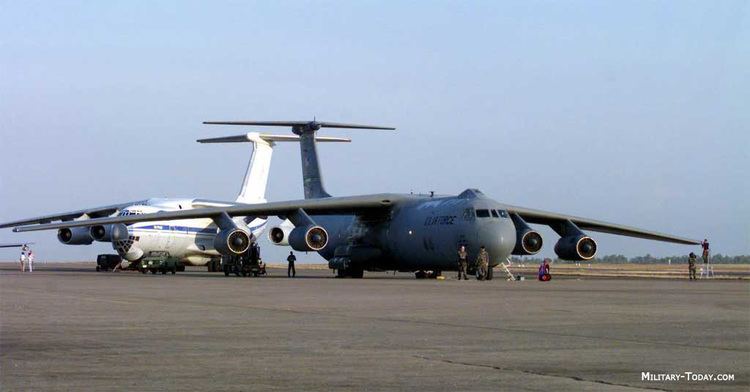
In the early 1960s, the United States Air Force's Military Air Transport Service (MATS) relied on a substantial number of propeller-driven aircraft for strategic airlift. As these aircraft were mostly obsolescent designs and the Air Force needed the benefits of jet power, the USAF ordered 48 Boeing C-135 Stratolifters as an interim step. The C-135 was a useful stop-gap, but only had side-loading doors and most bulky and oversize equipment would not fit, especially that employed by the U.S. Army.
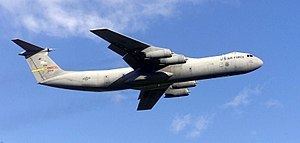
In the spring of 1960 the Air Force released Specific Operational Requirement 182, calling for a new aircraft that would be capable of performing both strategic and tactical airlift missions. The strategic role demanded that the aircraft be capable of missions with a radius of at least 3,500 nautical miles (6,500 km) with a 60,000 pounds (27,000 kg) load. The tactical role required it to be able to perform low-altitude air drops of supplies, as well as carry and drop combat paratroops. Several companies responded to SOR 182, including Boeing, Lockheed, and General Dynamics.

Lockheed responded to the requirement with a unique design: the Lockheed Model 300, the first large jet designed from the start to carry freight. The Model 300 had a swept high-mounted wing with four 21,000 pounds-force (93 kN) thrust TF33 turbofan engines pod-mounted below the wings. An important aspect was the cabin's floor height of only 50 inches (130 cm) above the ground, allowing easy access to the cabin through the rear doors. The two rear side doors were designed to allow the aircraft to drop paratroops (in August 1965 the aircraft performed the first paratroop drop from a jet-powered aircraft). The rear cargo doors could be opened in flight for airborne cargo drops. The high-mounted wings gave internal clearance in the cargo compartment of 10 feet (3.0 m) wide, 9 ft (2.7 m) high and 70 ft (21 m) long. The size enabled the Starlifter to carry, for example, a complete LGM-30 Minuteman intercontinental ballistic missile in its container. The aircraft was capable of carrying a maximum of 70,847 pounds (32,136 kg) over short distances, and up to 92,000 pounds (42,000 kg) in the version configured to carry the Minuteman, which lacked other equipment. The aircraft could also carry up to 154 troops, 123 paratroops or 80 litter patients.
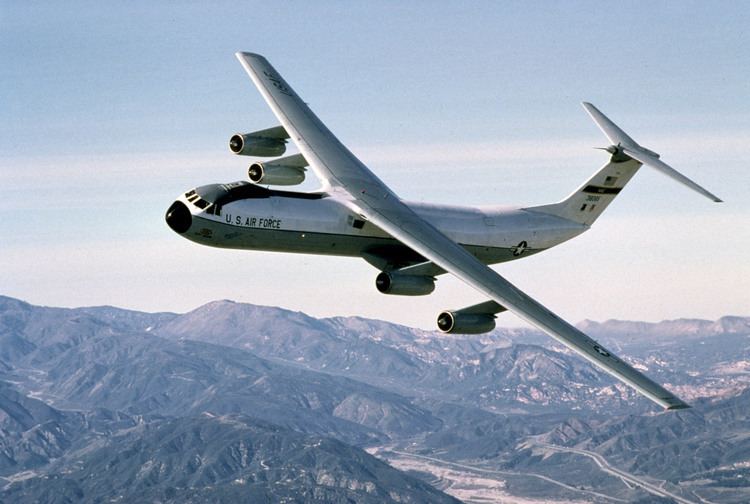
President John F. Kennedy's first official act after his inauguration was to order the development of the Lockheed 300 on 13 March 1961, with a contract for five aircraft for test and evaluation to be designated the C-141. One unusual aspect of the aircraft was that it was designed to meet both military and civil airworthiness standards. The prototype C-141A serial number 61-2775 was manufactured and assembled in record time. The prototype was rolled out of the Lockheed factory at Marietta, Georgia on 22 August 1963 and first flew on 17 December, the 60th anniversary of the Wright brothers' first flight. The company and the Air Force then started an operational testing program and the delivery of 284 aircraft.
An effort to sell the aircraft on the civilian market resulted in provisional orders from Flying Tiger Line and Slick Airways for four aircraft each. These were to be a stretched version, 37 feet (11 m) longer than the C-141A, and marketed as the L-300 SuperstarLifter. Other changes were also incorporated to make it more commercial, including a different yoke. The development was not sustained and only one civilian demonstration aircraft was built. When no commercial sales were made Lockheed donated the aircraft to NASA.
Operational history
The prototype and development aircraft then began an intensive operational testing program including the first delivery to MATS (63-8078) on 19 October 1964 to the 1707th Air Transport Wing, Heavy (Training), Tinker Air Force Base, Oklahoma. Testing continued and a Federal Aviation Authority type certificate was awarded on 29 January 1965. The first delivery to an operational unit (63-8088) was made on 23 April 1965 to the 44th Air Transport Squadron, 1501st Air Transport Wing, Travis Air Force Base, California. Although operational testing continued, due to the United States' military involvement in South Vietnam, the C-141 was soon employed in operational sorties to the combat zone.
On 8 January 1966, following the disestablishment of MATS, all C-141s were transferred to the newly established Military Airlift Command (MAC).
In October 1973, C-141s and C-5s airlifted supplies from the United States to Israel during the 1973 Yom Kippur War as part of Operation Nickel Grass. Over the course of the operation, C-141s flew 422 missions and carried a total of 10,754 tons of cargo.
The first strategic airlift flight of Operation Desert Shield was flown by a MAC C-141 of the 437th Military Airlift Wing out of Charleston AFB, SC, on 7 August 1990. The C-141 proved to be a workhorse airlifter of Operations Desert Shield and Desert Storm, flying 159,462 short tons (144,661,000 kg) of cargo and 93,126 passengers during 8,536 airlift missions.
On 1 June 1992, following the disestablishment of Military Airlift Command, all C-141s and the airlift wings to which they were assigned were transferred to the newly established Air Mobility Command (AMC). Air Force Reserve Command (AFRC) and Air National Guard (ANG) C-141s and units were also transferred to AMC.
On 16 September 2004, the C-141 left service with all active duty USAF units, being confined to Air Force Reserve and Air National Guard units for the remainder of its operational service life. As of 25 September 2005, there were only eight C-141 aircraft still flying, all from the Air Force Reserve's 445th Airlift Wing (445 AW) at Wright-Patterson AFB. In 2004, 2005, and 2006, the C-141s assigned to the 445 AW participated in missions to Iraq and Afghanistan, mostly for the medical evacuation of wounded service members. The last eight C-141s were officially retired in 2006.
In 1994 one of the aircraft at Wright-Patterson AFB was identified by its crew chief as the Hanoi Taxi (AF Serial Number 66-0177), the first aircraft to land in North Vietnam in 1973 for Operation Homecoming in the final days of the Vietnam War, to repatriate American POWs from North Vietnam.
In 2005, Hanoi Taxi and other aircraft were marshalled by the Air Force to provide evacuation for those seeking refuge from Hurricane Katrina. This aircraft and others evacuated thousands of people, including the medical evacuation (MEDEVAC) of hundreds of ill and injured.
With the 5 May 2005 announcement of the retirement of these last eight C-141s, the Hanoi Taxi embarked on a series of flights, giving veterans, some of whom flew out of POW captivity in Vietnam in this aircraft, the opportunity to experience one more flight before retirement. On 6 May 2006, the Hanoi Taxi landed for the last time and was received in a formal retirement ceremony at the National Museum of the United States Air Force, located at Wright-Patterson Air Force Base near Dayton.
15 aircraft including the "Hanoi Taxi" are now on static display at various air museums around the United States, all the remaining airframes retired to the "boneyard" at Davis-Monthan AFB, Arizona have been scrapped.
C-141A
The original Starlifter model, designated C-141A, could carry 154 passengers, 123 paratroopers or 80 litters for wounded with seating for 16. A total of 284 A-models were built. The C-141A entered service in April 1965. It was soon discovered that the aircraft's volume capacity was relatively low in comparison to its lifting capacity; it generally ran out of physical space before it hit its weight limit. The C-141A could carry ten standard 463L master pallets and had a total cargo capacity of 62,700 pounds (28,400 kg). It could also carry specialized cargoes, such as the Minuteman missile.
NASA obtained Lockheed's C-141 demonstrator, designated L-300. The airplane was modified to house the Kuiper Airborne Observatory telescope for use at very high altitudes. This NASA NC-141A is now in storage at NASA Ames Research Center, Moffett Federal Airfield, CA.
C-141B
In service, the C-141 proved to "bulk out" before it "grossed out", meaning that it often had additional lift capacity that went wasted because the cargo hold was full before the plane's weight capacity had been reached. To correct the perceived deficiencies of the original model and utilize the C-141 to the fullest of its capabilities, 270 in-service C-141As (most of the fleet) were stretched, adding needed payload volume. The conversion program took place between 1977 and 1982, with first delivery taking place in December 1979. These modified aircraft were designated C-141B. It was estimated that this stretching program was equivalent to buying 90 new aircraft, in terms of increased capacity. Also added was a boom receptacle for inflight refueling. The fuselage was stretched by adding "plug" sections before and after the wings, lengthening the fuselage a total of 23 feet 4 inches (7.11 m) and allowing the carriage of 103 litters for wounded, 13 standard pallets, 205 troops, 168 paratroopers, or an equivalent increase in other loads.
SOLL II
In 1994, a total of 13 C-141Bs were given SOLL II (Special Operations Low-Level II) modifications, which gave the aircraft a low-level night flying capability, enhanced navigation equipment, and improved defensive countermeasures. These aircraft were operated by AMC in conjunction with Air Force Special Operations Command (AFSOC).
C-141C
A total of 63 C-141s were upgraded throughout the 1990s to C-141C configuration, with improved avionics and navigation systems, to keep them up to date. This variant introduced some of the first glass cockpit technology to the aircraft, as well as improving reliability by replacing some mechanical and electromechanical components with their electronic equivalents.
Operators
United States Air Force - 284 C-141A, B, and C
Military Air Transport Service(source - "USAF C-141 Starlifter Units"; AMC Office of History, 2006)
NASA - 1 C-141A Construction Number 300-6110. Did not receive a USAF serial number, was flown with civil registration N4141A and later as NASA N714NA. Operated 1966-1995.
Accidents
19 C-141s were destroyed in accidents through 2005.
Aircraft on display
Specifications (C-141B Starlifter)
Data from Simviation.com
General characteristics
Performance
